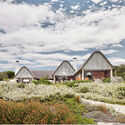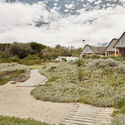
-
Architects: Bert Pepler Architects
- Area: 753 m²
- Year: 2017
-
Photographs:Greg Cox/ Bureaux, Bert Pepler
-
Landscape: Tarna Klitzner Landscape Architects, Tarna Klitzner

Text description provided by the architects. Located on the Kromme River estuary, that flows into the warm Indian ocean, the house has been conceptualized as a summer retreat for a family living in London. The long and narrow, 3330m2 site is positioned in an older part of the village, stretching from the street to the river. Flanked on both sides by neighboring properties, the site faces north with a south entry approach. The adjoining house, set among established trees and indigenous vegetation is one of the original St Francis Bay bungalows. The vernacular, which is a combination of fisherman’s cottage and Cape farm architecture, provided a reference point for the project. Architectural guidelines exist for the village, with white rendered walls and pitched roofs in either thatch or slate being a requirement. In addition environmental regulations prevent development within 20 meters from the river.



The original house was positioned at the rear of the site, devoid of the endemic landscape and was demolished to make way for a fresh new approach. The environment is idyllic, but conditions can change unexpectedly, with the prevailing winds from the east and west being strong design determinants. The overriding design concept was to use architectural elements to make the connection from the land to the water. Linear, finger-like forms extend from the street guiding one from the approach through the house, to the living areas and external terraces beyond. In contrast to the linearity of the forms, three large sculptural chimneys anchor the house and provide the verticality required to balance the composition. Magnificent vistas of the river are viewed over the indigenous garden, which extends down to merge with the river grasses on the beach.

The house is positioned at the rear of the site, with a vehicular graveled courtyard enclosed behind low walls facing the street. The thatch roofs and curved bagged walls are contemporary in a manner yet reminiscent of traditional Cape farm architecture. The buildings are single storey and provide an unimposing, intimate scale on approach. The simplicity and purity of form are inviting and continue throughout, making up the structure that informs the planning layout of the house. These “simple barn-like forms are placed in a series of parallel and perpendicular configurations to create “little werfs”, the local term for farm courtyards. These in turn create varying degrees of shelter and privacy, and integrate indoor and outdoor space, while the longitudinal barns telescope your eye towards the view. The “barns” and the courtyards between them ensure sheltered outdoor spaces, irrespective of the wind direction.

Each barn serves a different function: the first is a service wing housing a garage and kitchen, two are for outdoor entertainment, one for the living and dining spaces and two are for sleeping. The courtyards have been planted with indigenous grasses, shrubs, and trees to reintroduce the presence of the nearby coastal thicket. The eventual outcome is to create a canopy and greenery, where the forest is working its way through the house, and the house is working its way through the forest.

Where the house is required to open to outside, the large thatched roofs are supported on a series of over-scaled eucalyptus columns, reminiscent of pavilions. These pavilions can open entirely by sliding the glass doors and timber shutters aside into concealed cavities. When all are open, the structures feel like a series of thatched pavilions that allow the seamless free flow of movement from inside to out. Also, it allows for the uninterrupted transition from one courtyard through the house, to the next. This interrelationship is carried throughout the house, including service areas and bathrooms that open to private planted courtyards, illuminated by natural light.

The buildings are open and relaxed and finished with a palette of natural materials, providing a neutral backdrop for colourful furnishing and brass detailing in contrast. The consistent use of a limited pallet of materials create a cohesive interior, instilling a sense of light and calm. The roof is a complex piece of engineering, robust and organic. Constructed from poplar beams, the structure is reminiscent of the inverted hull of a boat. In contrast, the traditional solid gables are replaced by slatted, aluminum screens, allowing sunlight to filter through during the day, while becoming transparent and gauze-like, illuminating the interior structure at night. Sliding timber shutters screen the rooms, providing privacy and shade and containment when required.



The children’s bedrooms open up onto the entrance courtyard providing a safe and sheltered area in which to play. Two of the bedrooms have sleep lofts as does the playroom, and along with the window seats in the bedrooms, provide guests with additional sleeping space.

From the elevated living room terrace, generous outdoor sitting spaces open to the view. Flanked on one end by the main bedroom wing and the 18m swimming pool on the other, their linearity accentuates the perspective, opening up the view to the river. The pool with its long, low, white walls is reminiscent of an old reservoir while relating to the of the curve's house. Indigenous dune forest vegetation was reinstated, the gray tones reinforcing the colours that predominate in the house. From the poolside deck, timber boardwalks meander through the garden, leading down to a little beach in front of the river with a jetty - it's here the family spend their holiday, playing on the river.







































